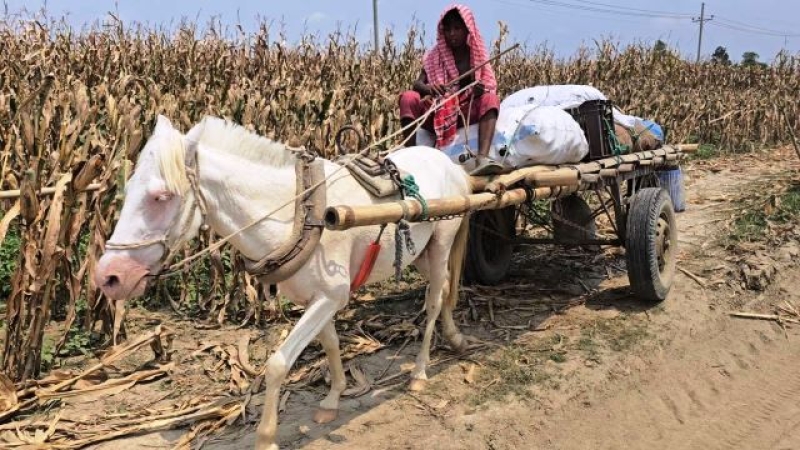- UN Calls for Calm in Bangladesh After Protest Leader’s Killing |
- DMP issues 7 traffic directives for Osman Hadi’s Janaza |
- Vested quarter fuelling chaos to impose new fascism: Fakhrul |
- Hadi’s namaz-e-janaza at 2:30pm Saturday |
- Jashore’s Gadkhali blooms with hope; flowers may fetch Tk4 bn |
How hackney carriages, motorbikes drive life in Faridpur's new isles

A horse cart being used to carry goods to remote isles of Faridpur in Bangladesh
Faridpur, May 20 -As rivers dry up and new lands emerge in Faridpur, horse carts and motorbikes have become vital tools for survival in its remote char areas.
In Faridpur, a south-central district of Bangladesh crisscrossed by major rivers such as the Padma, Madhumati and Arial Kha, the emergence of charlands has become a permanent reality where around 1,00,000 people now reside across 13 union parishads situated on these riverine islands.
As agriculture dwindles due to erratic weather and declining water levels, and fishing becomes less viable, locals have adapted.
For many, that adaptation has come in the form of horse carts and motorbikes—unconventional but vital lifelines for transport and trade.
Once reliant on ox carts to transport goods and people, char dwellers found the slow, cumbersome method ill-suited to the long and sandy trails that now criss-cross the region.
In recent years, horse carts and motorbikes have emerged as more efficient alternatives.
“The harsh geography of the chars makes traditional travel nearly impossible,” said Rakib Sheikh, a horse cart operator in Char Harirampur, a part of the Padma river charland under Charbhadrasan Upazila.
“There are no proper roads and during most of the year, it’s just sand. But we still need to move goods and people,” he said.
Despite the challenges—navigating deep sand, soft muddy stretches and an absence of basic infrastructure—these vehicles are now central to the region’s informal economy.
Riders and cart drivers earn between Tk 1,000 and Tk 3,000 per day, depending on the season and workload.
A horse cart can carry up to 800 kilogrammes of goods across the uneven terrain, while a motorbike often carries up to two passengers.
Residents’ Hardship
Access remains the biggest hurdle for char residents.
Mahbuba Parvin and Jakibur Hossain, teachers at Char Salepur Government Primary School, said during the dry season, the char becomes almost entirely disconnected.
“People are compelled to rely on horse carts, motorbikes and boats to access markets, schools or health services. Yet these modes of transport often become risky, especially when navigating soft, shifting sands,” said Mahbuba.
Due to poor agricultural output and decreasing fish stocks, many residents have been forced to shift professions.
“The younger generation is increasingly turning to transport work,” said Md Habibur Rahman, an assistant teacher at Char Salepur High School.
“These vehicles are not just a means of mobility—they're a livelihood now," he said.
Climate’s Contribution
“Climate change is not a distant threat—it’s here, transforming our rivers and our lives,” said Khondaker Mahfuzul Alam Milon, a cultural activist and environmentalist from Faridpur.
“Desertification is creeping in and water only flows during the monsoon months. The rest of the year, the rivers are dry, the chars are dusty plains and the number of emerging charlands is increasing," he said.
He underscored the importance of both government and community initiatives to improve the lives of char dwellers.
“To improve living conditions on the chars, we need a combined effort from the state and society. And those illegally extracting sand from rivers, disrupting their natural flow, must be held accountable under strict laws,” he added.
An on-spot visit to the charlands of Faridpur revealed a deeper narrative that horse carts and motorbikes trudging through these sandy stretches are more than mere modes of transport; they embody the resilience and adaptation of communities grappling with ecological uncertainty.
*With additional inputs from Julfekar Dehan. - UNB

